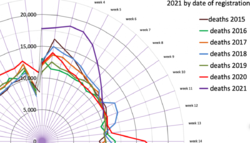Poacher
Gravitationally challenged member
- Location
- Nottingham
There have been fairly strong suspicions that cause of death figures have been adjusted downwards under pressure from politicians.Thank you for that balanced contribution. No amount of bragging or modesty (eg Vermont) is any consolation to the families of those who've died or to those who are still suffering. You don't know that other policies would have been better for Florida, whatever their intelligence quotient.
Fact Check: Deaths in Florida due to COVID-19 (as registered) show as 33+k to end March. This is quite a way short of 40k.
Average annual deaths in Florida is about 200k.
If you would prefer to look at excess deaths (since Mar 2020) then there's probably been over 40k in 13 months - but not all are COVID-19 directly.
Florida medical examiners were releasing coronavirus death data. The state made them stop. (tampabay.com)
Florida is undercounting COVID-19 deaths, per new report | Blogs (orlandoweekly.com)


